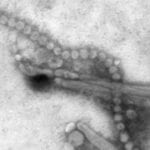 Researchers supported in part by the National Institute of Allergy and Infectious Diseases (NIAID) have used virus isolated from a person who died from H7N9 avian influenza infection to determine whether the virus could infect and be transmitted between ferrets.
Researchers supported in part by the National Institute of Allergy and Infectious Diseases (NIAID) have used virus isolated from a person who died from H7N9 avian influenza infection to determine whether the virus could infect and be transmitted between ferrets.
Ferrets are often used as a mammalian model in influenza research, and efficient transmission of influenza virus between ferrets can provide clues as to how well the same process might occur in people.
The researchers dropped H7N9 virus into the noses of six ferrets. A day later, three uninfected ferrets were placed inside cages with the infected animals, and another three uninfected ferrets were placed in cages nearby. All the uninfected ferrets inside the cages became infected, while only one of three placed in nearby cages became infected.
The team concluded that the virus can infect ferrets and be transmitted between ferrets both by direct contact and, less efficiently, by air. The scientists detected viral material in the nasal secretions of the ferrets at least one day before clinical signs of disease became apparent. The potential public health implication of this observation is that a person infected by H7N9 avian influenza virus who does not show symptoms could nevertheless spread the virus to others.
The researchers also infected pigs with the human-derived H7N9 virus. In natural settings, pigs can act as a virtual mixing bowl to combine avian- and mammalian-specific influenza strains, potentially allowing avian strains to better adapt to humans. New strains arising from such mixing have the potential to infect humans and spark a pandemic, so information about swine susceptibility to H7N9 could help scientists gauge the pandemic potential of the avian virus.
Unlike the ferrets, infected pigs in this small study did not transmit virus to uninfected pigs, either through direct contact or by air. All the infected ferrets and pigs showed mild signs of illness, such as sneezing, nasal discharge, and lethargy, but none of the infected animals became seriously ill.
Read the study at Science: Infectivity, transmission and pathogenesis of human-isolated H7N9 influenza virus in ferrets and pigs.
Source: National Institute of Allergy and Infectious Diseases

